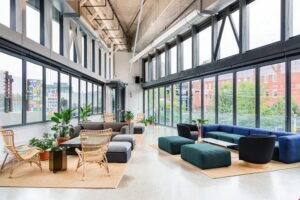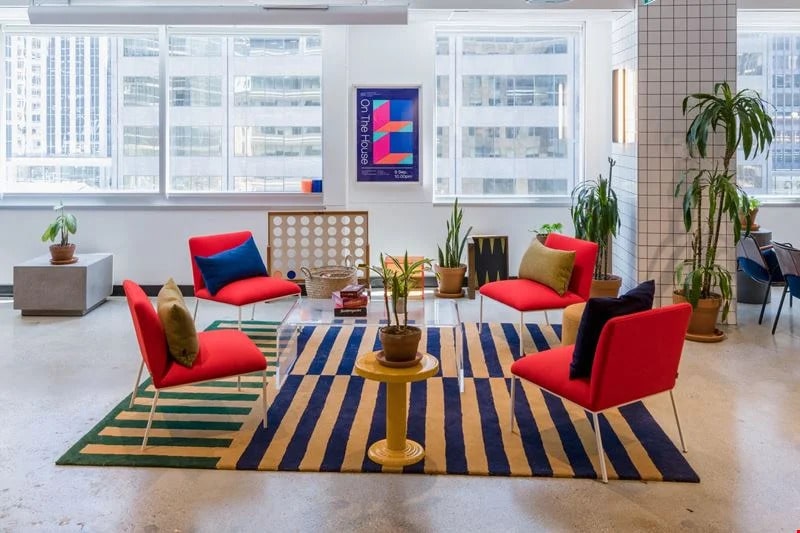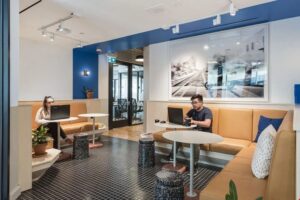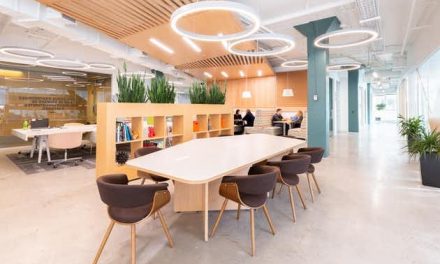Hybrid work environments are here to stay, demanding new and innovative design strategies that seamlessly combine the comfort of a home with the practicality and functionality of an office. As employees learn to adapt and grow to this new landscape, so must their work environments.
In this article, we will explore the interior design principles and architectural innovations that are used to create these finely balanced workplaces. Enabling maximum productivity and collaboration, while also ensuring employees are satisfied and comfortable whilst completing their tasks, makes for a lot to unpack about the hybrid work model, so let’s get into the nitty-gritty.
What is a hybrid workspace?
Hybrid workspaces are a working environment that facilitates both in-office workers and remote workers, allowing employees to choose how and where they work on a daily basis.
A hybrid workspace is a general term as these environments can vary depending on the industry type and the needs of individuals. For example, some hybrid workspaces may have permanent in-office workers while others may allow for maximum flexibility so employees can alternate where they work from as they see fit.
As we saw with the global pandemic, things can change extremely quickly, forcing businesses to evolve. Even now, the Chinese housing market is impacting prices abroad, which could lead to thousands of US businesses seeking smaller premises. Adopting a hybrid working environment now makes adapting to such challenges much easier.
Advantages of hybrid workspaces
With 84% of remote workers saying they’re actually willing to move on to a hybrid model, it’s crucial to ponder about what makes employees so eager and employers so willing to listen. Mainly, it’s because a well-designed hybrid workspace:
- Future-proofs businesses and organizations so they can adapt to modern working practices.
- Improves the employee experience by creating a better work-life balance.
- Enables collaboration and engagement between employees in a modern environment.
- Helps businesses reduce costs. E.G. lower rent, lower utility bills, fewer office supplies being used, etc.
- Employees can also save money by not being required to commute each day.
- Businesses can redirect financial savings into other areas of the business such as employee training.
- Hybrid environments allow businesses to access a wider talent pool by acquiring remote workers who are not local to the office or may not even be based in the same country.
Hybrid workspaces: Challenges
While everyone immediately thinks of cultural challenges when it comes to hybrid work environments, the truth is that organizations also have to tackle:
- Temporary issues if client-facing employees decide to work remotely, with some clients showing a reluctance to use video calls and virtual meeting software as a form of communication.
- The mere fact that, for some professions and positions, going beyond work is unnecessary. This can create friction, especially if the employee is reluctant to venture to the office.
- Burnout and overworking. The well-being of remote workers must be considered, ensuring workers take regular breaks and do not work late into the night.
- The growing number of cybersecurity threats, with external devices and applications creating unique threats.
Hybrid workplaces: The 4 key design pillars
As the workforce becomes more transient, traditional office spaces become feasible. Unable to adapt to flexible working styles and new habits. Requiring a rethink of office spaces and how they can accommodate remote workers and those who are there physically.
Therefore, when designing a hybrid workspace, four key principles need to be adhered to ensure the environment meets the needs of the employees using it:
1. Flexibility: Multifunctional workspaces
The number of people in the office can greatly fluctuate at any one time, with some days much busier than others, and certain hours of the day seeing a higher occupancy.
As a result, the concept of having a designated workstation becomes infeasible which has resulted in the rise of ‘hot-desking’ or developing a scheduling system to allocate desks. When the number of workstations is reduced, scheduling tools become essential to manage the office effectively, making sure available desk space has not been over-allocated.
Also, you shouldn’t be afraid of merging the social and technological elements of hybrid workspaces. If there’s, for instance, a new internal program you want employees to sign up for, why not use a QR code for registration and place them so your team members can join with just a few taps on their phone? It’s the room for these creative endeavors that sets apart hybrid from traditional workspaces.
Agile design techniques are also required to better accommodate this shift and to make the most of a limited amount of workstations. While spatial design is at the forefront, most modern teams solve this through the help of software.
2. Inclusivity: Allowing for different working styles and tasks
Although most work environments have moved to a more open and collaborative style, the need for privacy and secluded settings still remains.
There may be times when an employee needs complete peace and quiet, with zero distractions to meet a deadline, for example. This is why a hybrid workspace needs to be inclusive of all employees and their current situation.
Hybrid workspaces need an adaptable layout, including small areas such as a soundproof meeting pod or individual cubicles. This makes it possible to hold meetings that could be of a sensitive nature and to give employees a space to work with zero distractions.
3. Collaboration: Creating a sense of community
Creating a sense of community in the workplace is essential for building connections between employees which can result in increased productivity and a happier workforce. Better collaboration boosts knowledge sharing and promotes more sociable and engaged environments that help people feel valued and part of a team.
While it seems like a tall task, this is possible by establishing breakout zones where team members can discuss upcoming projects or bring up any concerns they may have. Meanwhile, establishing social outdoor spaces and communal areas where people can enjoy a coffee, eat lunch, or chat with friends provides employees with a comfortable place to unwind during the day.
4. Well-being — a better work-life balance
Hybrid workplaces can play a significant role in improving employee well-being, with a recent report showing that 48% of Americans are dissatisfied with their well-being at work. A hybrid environment offers a better work-life balance when compared to a traditional office structure, helping to reduce the stress and fatigue that can come with the daily commute.
Psychologically, a person is happier when they have more control, and a hybrid working environment provides this, allowing people to decide on whether they work remotely or not. To enable this, workplaces need to be designed to have a casual but professional feel, bridging the gap between an office environment and home comforts.

Architectural innovations for hybrid workspaces
Modular architecture is at the forefront of the hybrid workspace revolution, helping organizations to create multi-functional zones in a limited amount of space.
Innovations such as the Omniroom by Mute Design are effectively rooms within rooms, creating a quick and simple solution for businesses to customize workspaces to suit their needs. Likewise, there have been plenty of advancements in regard to smart offices, biophilic workspaces and expanded storage facilities for workers who commute long distances.
These solutions make it possible to have workstations, a meeting room, and a shared communal area in a limited amount of space, with the option to tailor the layout to meet the workforce’s requirements.
In addition, more and more employers are willing to work with employees on financing home office refurbishments, new tech devices, and more. After all, joining the remote and in-office aspects is the only way to make hybrid workspaces truly functional.
Conclusion
Hybrid workplaces have become a permanent concept that is being adopted by small and large businesses, alike. However, many businesses still don’t fully understand the benefits of this concept and fail to design effective workspaces that boost productivity and employee satisfaction.
Following simple design principles and using architectural innovations such as modular rooms and furniture can help to turn even a small space into an environment that is highly functional, flexible, and fully-inclusive.










